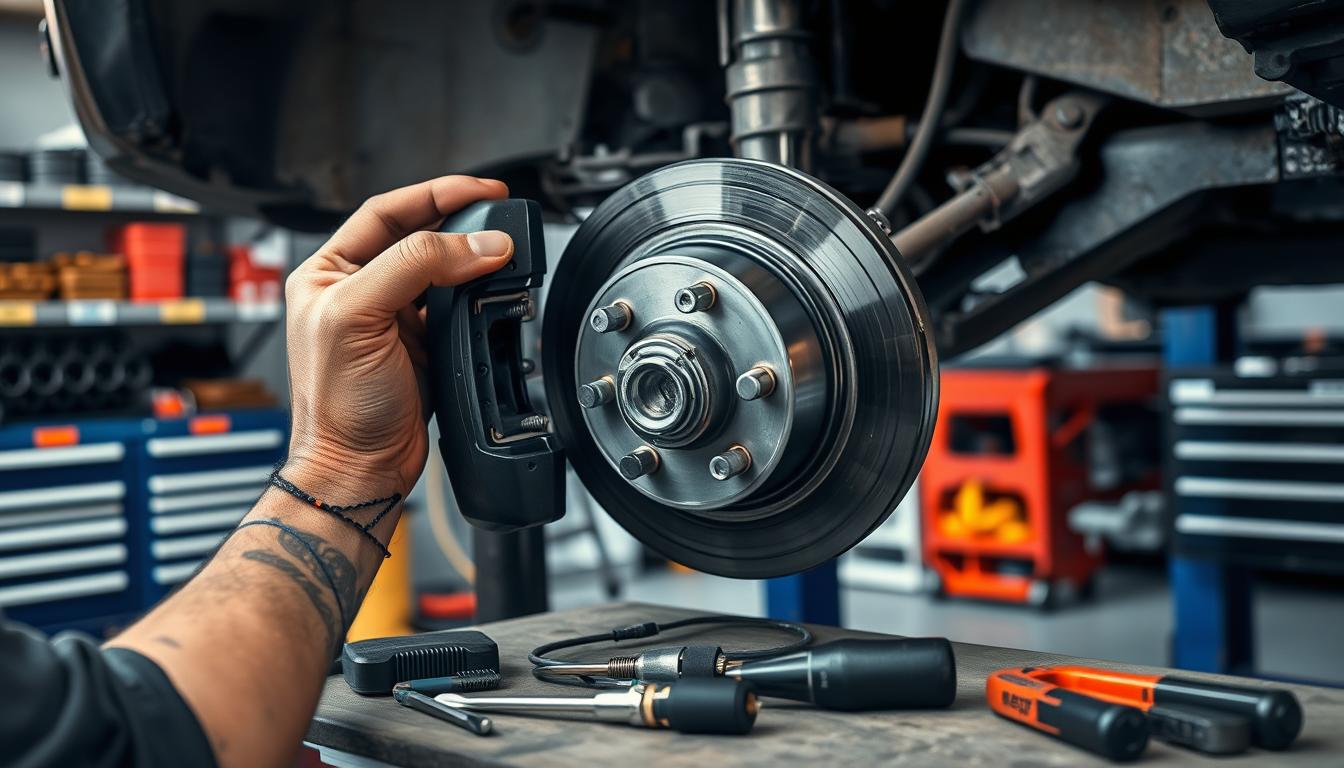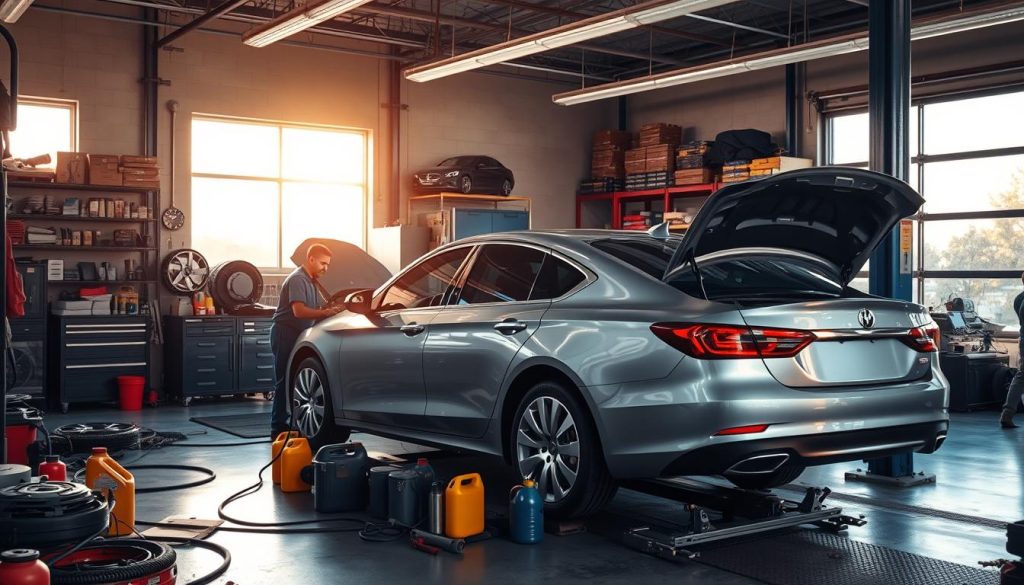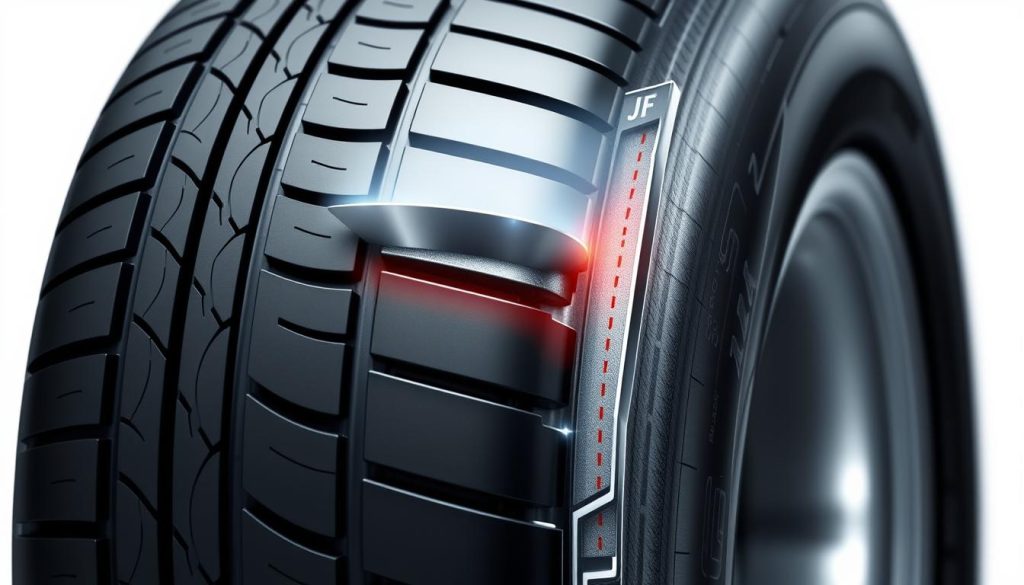Knowing when to check your brakes is key for safety. Most cars need about 100 yards to stop from 60 miles per hour. This shows how important good brakes are.
Keeping an eye on your brakes helps you stop fast. It also keeps you safe from accidents. Regular brake checks are a must for your car to run well.
Key Takeaways
- Regular brake inspections are vital for safe vehicle operation.
- Brake fluid changes can prevent corrosion and enhance braking performance.
- Monitoring brake fluid levels is critical for emergency stopping ability.
- High-quality brake pads offer better safety and last longer.
- Driving habits greatly affect brake wear; better habits help.
- Routine inspections catch small problems before they get big and expensive.
- Keeping a safe distance from other cars reduces brake wear and boosts safety.
Signs Your Brakes Need Immediate Attention
Knowing when our brakes need help can stop big problems later. Many drivers miss important signs, not knowing the dangers. By watching for certain signs, we keep our cars safe and working well.
Squeaking or Grinding Noises
Listen for squeaks or grinds when you brake. These brake noises mean your brake pads or rotors are worn out. A squeal means pads are almost gone, and a grind means they’re completely worn, causing damage if not fixed fast.
Vibration or Pulsation When Braking
Feeling brake vibration or pulsation when stopping is a warning. It means your rotors might be warped or uneven. Uneven wear can cause brakes to fail, so fixing it early is key for safety.
Warning Lights on Your Dashboard
Modern cars have brake warning lights on the dashboard. If these lights come on, it means something’s wrong, like low brake fluid or worn parts. Sadly, 25% of drivers ignore these lights, which raises the risk of accidents. We must take care of our cars when these lights go on.
Spotting these signs early and acting fast can avoid expensive brake repair San Antonio. Regular checks and upkeep greatly lower the chance of major brake problems. This makes driving safer for everyone.
Importance of Regular Brake Inspections
Regular brake checks are key to keeping our vehicles safe. They help our brakes work well. This saves us money on repairs.
Enhancing Vehicle Safety
Brakes are super important for safety. They help us stop fast, which lowers accident risk. If we ignore them, our brakes might not work right.
This can make stopping harder. It’s also risky because brakes can fail. About 25% of accidents are because of brake failure.
Checking brakes often can spot problems like leaks. These happen in about 15% of cars. Fixing these early makes driving safer.
Preventing Costly Repairs
Regular brake checks can save us money. If we ignore them, small problems can become big and expensive. Studies show routine checks can make brake parts last up to 30% longer.
This means we spend less on repairs. It also means we use better brake parts. A pro can find issues we might miss, like a soft brake pedal.
This can mean avoiding big repair bills later. It’s a smart move for our wallets and safety.
How to Check Your Brake Fluid
Checking brake fluid is key to keeping our cars safe. We should look at the brake fluid levels often. They should be clear to light yellow. If they’re dark or murky, it’s time for a brake fluid change.
Knowing when to change brake fluid is important. It helps our brakes work well.
Understanding Brake Fluid Levels
It’s important to watch the brake fluid levels. You can find the brake fluid reservoir at the back of the engine. If the fluid looks off, it’s time for a brake fluid check.
Good brake fluid stops moisture from getting in. This keeps our brakes working right.
When to Change Brake Fluid
Knowing when to change brake fluid is key. Car makers say to do it every two years or after 24,000 miles. If the brake fluid has too much moisture, change it right away.
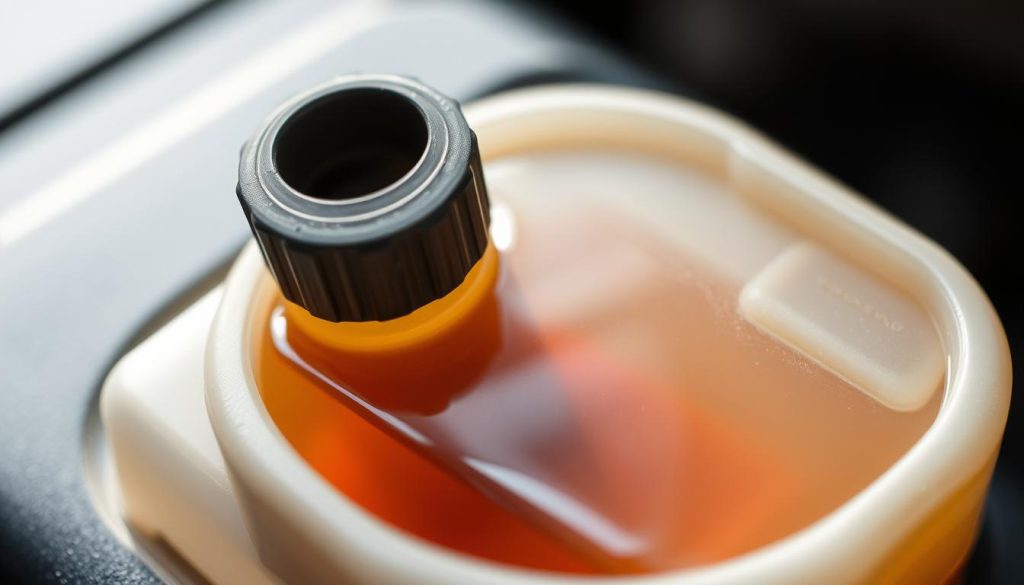
Monitoring Brake Pad Wear
The health of our vehicle’s braking system depends on the brake pads. It’s important to know how to check brake pad wear. This keeps us safe and our vehicle running well.
Indicators of Worn Brake Pads
There are signs to watch for to know if brake pads are worn. Look out for:
- Squeaking or squealing noises while braking
- Grinding sounds when brakes are applied
- A decrease in braking efficiency or responsiveness
These signs mean we need to check brake pads right away. If we ignore them, bigger problems could happen, risking our safety.
Lifespan of Brake Pads
Brake pads last from 25,000 to 65,000 miles, based on how we drive. Driving in heavy traffic or stopping hard often wears them down faster. We should watch our car’s mileage and how it brakes to know when to replace the pads.
Impact of Driving Habits on Brake Life
How we drive affects our brakes a lot. Good driving habits can make our brakes last longer. It also makes our cars safer.
Knowing how our driving habits impact our brakes is key. It helps us make choices that keep our brakes working well for longer.
Aggressive Driving Patterns
Driving fast and stopping hard wears out brakes fast. This stress makes brake pads and rotors wear down quicker.
When going up steep hills, don’t ride the brakes. It’s better to brake smoothly and slowly. This helps your brakes last longer and work better.
Frequent Stop-and-Go Traffic
Driving in stop-and-go traffic is hard on brakes. It makes them wear out faster.
Try to keep a steady speed and plan for traffic lights. This makes braking less hard on your brakes. It also helps your car use less fuel and keeps your brakes in good shape.
Common Brake Problems in San Antonio
Driving in San Antonio can be tough. Weather and how old our cars are affect brakes a lot. Knowing this helps keep our brakes working well.
Weather Impact on Brake Performance
The humid weather in San Antonio can make brakes rust. Hot temperatures can also mess with brake fluid. These things can cause:
- Squeaking or grinding sounds when you press the brakes, meaning they’re worn out.
- A sinking brake pedal, which might mean there’s a leak and you should check it fast.
- Brake line leaks, making it harder to stop and needing quick fixes.
Age of Your Vehicle and Brake Wear
How old your car is affects its brakes. Older cars need more checks because:
- Worn-out brake pads don’t stop as well, making it harder to stop.
- Old parts can cause brake issues, needing quick fixes in San Antonio.
- Brake parts wear out faster, which can cost more to fix if you wait.
It’s important to get brakes checked often. This is true, given the local weather and car age. Regular checks can help avoid brake problems.
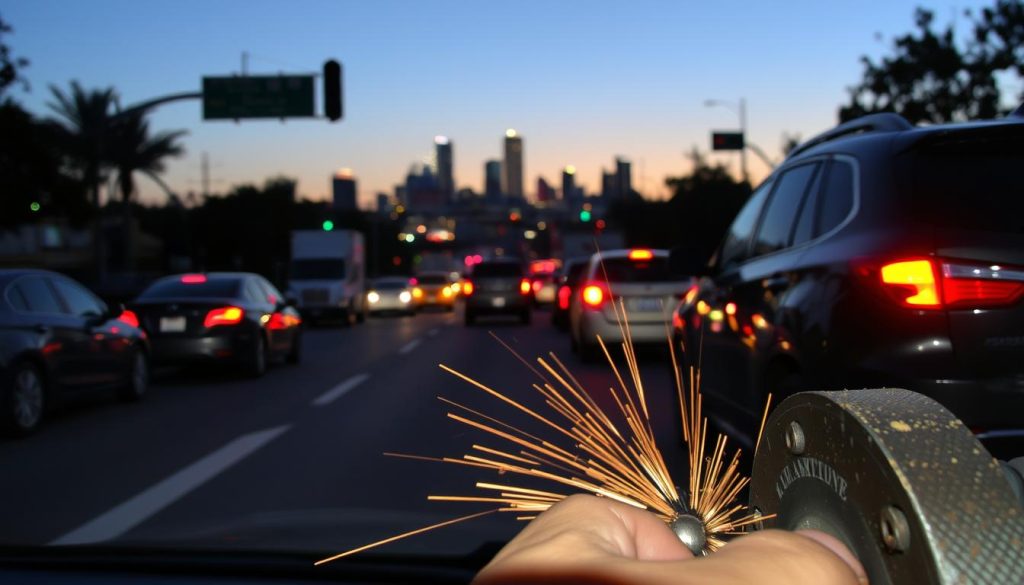
Professional Brake Repair Services in San Antonio
When we have brake problems, getting help from experts is key for safety and performance. Picking a good brake shop is important. Places like Heaven Automotive at 6645 Poss Rd, San Antonio, TX 78238, offer great solutions.
Choosing the Right Brake Shop
Finding a trustworthy brake shop in San Antonio is vital. Look for places with a good reputation, like NuBrakes. They are known for making customers happy. Here are important things to think about:
- Certifications: Make sure the techs are ASE-certified. This means they know a lot about brake repairs.
- Customer Ratings: Choose shops with great reviews. NuBrakes has a 4.94 out of 5 from over 14,270 customers.
- Transparent Pricing: Good shops give clear prices quickly. This helps us make smart choices.
Services to Expect from Professionals
When we choose professional brake repair, we get many services. These keep our cars running well. A typical service includes:
- Brake checks to find problems like worn pads or damaged rotors.
- Replacing brake pads and shoes to avoid more damage and keep us safe.
- Brake fluid flush to stop moisture problems that can harm brakes over time.
- Rotor resurfacing to make rotors like new again. This reduces noise and makes brakes work smoothly.
Using professional brake repair services makes our cars safer and can save money. By picking the right shop in San Antonio, we make sure our car gets the best care.
DIY Brake Inspections: What You Need to Know
Learning to check your brakes yourself is a great skill. It helps us find problems early and keeps our car safe. With the right tools and knowledge, we can do a detailed check. This saves us time and money.
Basic Tools for a Brake Check
To do a DIY brake check, you’ll need some basic tools. Make sure you have these before you start:
- Jack
- Lug wrench
- Brake fluid tester
- Measuring tool for brake pad thickness
Steps for a Thorough Inspection
Here’s how to check your brakes well:
- First, lift the car with a jack and take off the wheels. This lets you see the brake parts.
- Then, check the brake fluid levels. If they’re low, it might mean a leak.
- Look at the brake pads. If they’re too thin, you need to replace them.
- Check the rotors for cracks, grooves, or uneven wear. This is important for good braking.
- Lastly, check for leaks around brake lines and connections. Finding and fixing leaks is key for safety.
Regular checks help us keep an eye on our brake health. By doing a DIY brake check, we can spot problems early. This helps our brakes last longer.
Cost Factors for Brake Repair in San Antonio
Knowing how much brake repairs cost in San Antonio helps us plan our budget. Prices change a lot based on what repairs are needed and who does them. Simple repairs might cost $140, but complex ones can be over $1,000 per axle.
Average Prices for Brake Services
Looking at brake service costs, we see different prices for brake pads and rotors. Here are some estimates from different places:
- AutoZone: Brake pads ($35-$150), rotors ($60-$210), total cost estimate ($250-$500).
- RepairPal: Brake pads ($143-$164), rotors ($168-$233), total cost estimate ($473-$534).
- Kelly Blue Book: Brake pads ($96-$113), rotors ($110-$217), total cost estimate ($282-$424).
- Christian Brothers Automotive: Brake pad and rotor replacement costs ($380-$450).
- Firestone: Brake pads only ($250-$320), pads & rotors ($350-$450).
- Midas: Brake pads only ($200-$219), pads & rotors ($350-$400).
- Meineke: Brake pads only ($130-$500), pads & rotors ($345-$500).
- Pep Boys: Brake pads only ($209-$250), pads & rotors ($350-$435).
Factors Affecting Repair Costs
Many things can change how much brake repairs cost. How complex the repairs are is a big factor. Extra services like brake fluid flushes or caliper replacements can increase the cost. Labor costs can be between $50 to $200 per axle, depending on who you choose.
Where you live also affects brake repair prices in San Antonio. Cities usually cost more than rural areas. How you drive also matters. Aggressive driving can mean you need to replace brake pads and rotors more often, which can be expensive.
When to Schedule a Brake Inspection
It’s important to check our brakes regularly. This keeps our cars running smoothly and safely. We should check them at least once a year or every 12,000 miles.
If we drive a lot in heavy traffic or drive fast, we need to check them more often. This helps our brakes last longer.
Recommended Inspection Intervals
Having a regular brake check schedule is key. A good rule is to check them every 10,000 to 15,000 miles. But, if we notice anything strange, we should check them sooner.
This way, we keep our brakes working well. It makes sure we stay safe while driving.
Signs You Should Schedule Sooner
There are signs that mean we need to check our brakes sooner. If we hear squeaking or grinding sounds, or if the brake pedal feels soft, we should act fast. Seeing the brake light on our dashboard is also a warning.
Other signs like uneven brake wear or a pedal that goes all the way down are serious. We need to get them checked right away. This keeps us and others safe on the road.

